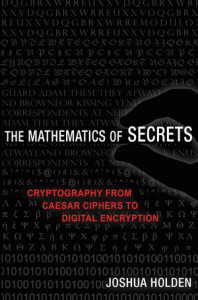 Ten days ago we posted a cryptogram puzzle, set by mathematician and author Josh Holden. We’ve had a number of entries, some which were so enthusiastic they ignored that we’d said to email them in and tried to post in the comments. However, from the correctly submitted entries, we had one stand-out winner – a quick reply, with a detailed description of the solution and a worthy recipient of a copy of The Mathematics of Secrets. Here’s Josh’s explanation of the puzzle, for anyone who hasn’t cracked it yet.
Ten days ago we posted a cryptogram puzzle, set by mathematician and author Josh Holden. We’ve had a number of entries, some which were so enthusiastic they ignored that we’d said to email them in and tried to post in the comments. However, from the correctly submitted entries, we had one stand-out winner – a quick reply, with a detailed description of the solution and a worthy recipient of a copy of The Mathematics of Secrets. Here’s Josh’s explanation of the puzzle, for anyone who hasn’t cracked it yet.
There is one thing more common that the letter “e” in English text — the space! In fact, if spaces between words are included in the count, they occur about 19% of the time. If you correctly guessed that “Q” in the cryptogram was actually a space, then you probably proceeded to guess that “F” was “e” and “Y” and “T” were “t” and “a”. Then you probably figured out the first and third words, and proceeded to decrypt the rest of the puzzle to reveal the beginning of Chapter XI of “Alice’s Adventures in Wonderland”. (If you didn’t figure any of that out, it’s not too late to finish solving the puzzle now!)
The complete key that I used to encrypt the message was:
abcdefghijklmnopqrstuvwxyz TWZCFILORUXADGJMPSVYBEHKNQ
There’s more about the M-209 in Section 2.8 of The Mathematics of Secrets.
where the letter “z”, which doesn’t actually occur in the original message, does double duty as the space character. The same use of the “z” as space occurred in the M-209, used by the U.S. Armed Forces for tactical purposes during World War II on a huge scale and continuing through the Korean War.
The interesting mathematical feature of the key is that starting with “T” for “a”, I counted three letters forward through the alphabet to get “W” for “b”. Then I picked off every third letter of the alphabet after that, wrapping around when I got to the end. In classical cryptography this was known as the “decimation method” and in modern cryptography it is called an affine cipher.
Much more about modular arithmetic and affine ciphers can be found in Chapter 1 of The Mathematics of Secrets.
The wrap-around is an example of modular arithmetic, which is an important component of many modern ciphers.
Well done to everyone who sent in an entry, and special congratulations to our winner, Mukund Thattai.